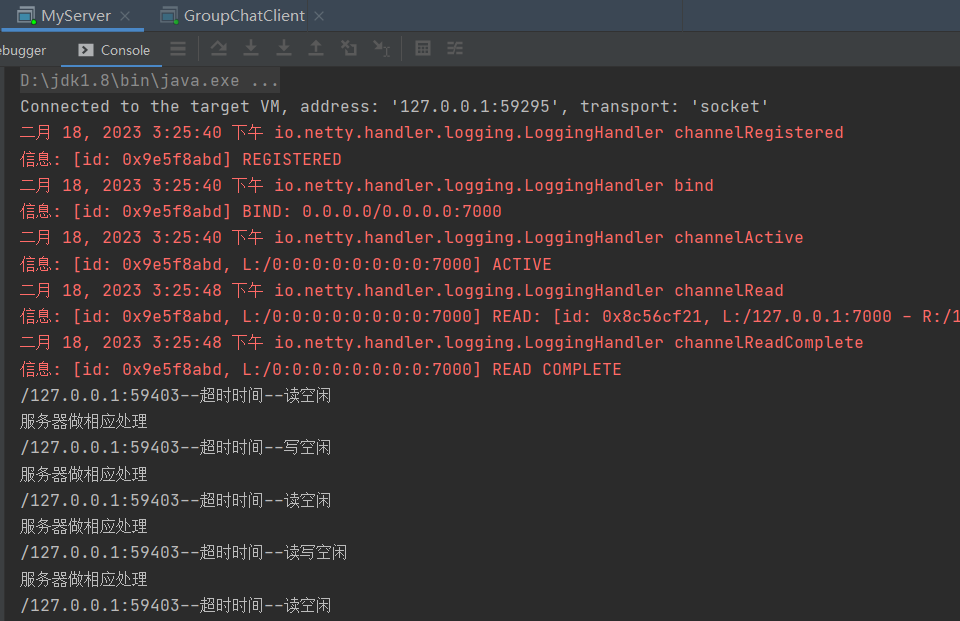netty心跳
为什么要引入心跳机制:
因为网络连接是不可靠的,像在TCP长连接或者webSocket长连接时都会使用心跳机制,即发送特殊的数据包告诉自己的业务没办完,不要关闭连接。
案例要求:
当服务器超过3秒没有读时,就提示读空闲
当服务器超过5秒没有写时,就提示写空闲
当服务器超过7秒没有读写时,就提示读写空闲
Netty中的心跳检测主要是通过IdleStateHandler这个类进行心跳的处理,它可以对一个Channel的读\写设置定时器,当Channel在一定时间间隔内没有数据交互时(即处于Idle状态)就会触发指定的事件
public IdleStateHandler(long readerIdleTime, long writerIdleTime, long allIdleTime, TimeUnit unit) {
this(false, readerIdleTime, writerIdleTime, allIdleTime, unit);
}
readerIdleTimeSeconds:设置读超时时间;
writerIdleTimeSeconds:设置写超时时间;
allIdleTimeSeconds:同时为读或写设置超时时间;
代码示例:
服务端代码:
public class MyServer {
//编写run方法,处理客户端请求
public static void main(String[] args) throws Exception{
NioEventLoopGroup bossGroup = new NioEventLoopGroup();
NioEventLoopGroup workGroup = new NioEventLoopGroup();
try {
ServerBootstrap serverBootstrap = new ServerBootstrap();
serverBootstrap.group(bossGroup,workGroup)
.channel(NioServerSocketChannel.class)
.option(ChannelOption.SO_BACKLOG,128)
.handler(new LoggingHandler(LogLevel.INFO))
.childHandler(new ChannelInitializer<SocketChannel>() {
@Override
protected void initChannel(SocketChannel ch) throws Exception {
//获取到pipeline
ChannelPipeline pipeline = ch.pipeline();
//加入一个netty 提供IdleStateHandler
/**
* 说明:
* 1.IdleStateHandler 是netty提供的处理空闲状态的处理量
* 2.readerIdleTime 表示多长时间没有读
* 3.writerIdleTime 表示多长时间没有写
* 4.allIdleTime 表示多长时间没有读写,就会发送一个心跳检测包检测是否连接
* 5. unit 时间单位
* 6.当IdleStateHandler触发后,就会传递给管道的下一个handle去处理,通过调用触发下一个handle的userEventTiggered
* 在该方法中去处理IdleStateHandler(读空闲、写空闲、读写空闲)
*/
pipeline.addLast(new IdleStateHandler(3,5,7, TimeUnit.SECONDS));
//加入一个空闲检测进一步处理的handle
pipeline.addLast(new MyServerHandle());
}
});
//启动服务器
ChannelFuture channelFuture = serverBootstrap.bind(7000).sync();
channelFuture.channel().closeFuture().sync();
}finally {
bossGroup.shutdownGracefully();
workGroup.shutdownGracefully();
}
}
}服务端处理器:
public class MyServerHandle extends ChannelInboundHandlerAdapter {
/**
*
* @param ctx 上下文
* @param evt 事件
* @throws Exception
*/
@Override
public void userEventTriggered(ChannelHandlerContext ctx, Object evt) throws Exception {
if (evt instanceof IdleStateEvent){
//将evt向下转型IdleStateHandler
IdleStateEvent event = (IdleStateEvent)evt;
String eventType = null;
switch (event.state()){
case READER_IDLE:
eventType = "读空闲";
break;
case WRITER_IDLE:
eventType = "写空闲";
break;
case ALL_IDLE:
eventType = "读写空闲";
break;
}
System.out.println(ctx.channel().remoteAddress()+"--超时时间--"+eventType);
System.out.println("服务器做相应处理");
}
}
}客户端代码:
public class GroupChatClient {
private final String host;
private final int port;
public GroupChatClient(String host, int port) {
this.port = port;
this.host = host;
}
public void run() throws Exception{
NioEventLoopGroup group = new NioEventLoopGroup();
try {
Bootstrap bootstrap = new Bootstrap()
.group(group)
.channel(NioSocketChannel.class)
.handler(new ChannelInitializer<SocketChannel>() {
@Override
protected void initChannel(SocketChannel ch) throws Exception {
//得到通道
ChannelPipeline pipeline = ch.pipeline();
pipeline.addLast("decoder",new StringDecoder());
pipeline.addLast("encoder",new StringEncoder());
//加入自己的业务处理handle
pipeline.addLast(new GroupChatClientHandle());
}
});
ChannelFuture channelFuture = bootstrap.connect(host, port).sync();
//得到channel
Channel channel = channelFuture.channel();
System.out.println("=================="+channel.localAddress()+"=====================");
///客户端需要输入信心,创建一个扫描器
Scanner scanner = new Scanner(System.in);
while (scanner.hasNextLine()){
String msg = scanner.nextLine();
//通过channel发送到服务器
channel.writeAndFlush(msg+"\r\n");
}
}finally {
group.shutdownGracefully();
}
}
public static void main(String[] args) throws Exception {
new GroupChatClient("127.0.0.1",7000).run();
}
}客户端处理器:
public class GroupChatClientHandle extends SimpleChannelInboundHandler<String> {
@Override
protected void channelRead0(ChannelHandlerContext channelHandlerContext, String msg) throws Exception {
System.out.println(msg.trim());
}
}启动服务端,再启动客户端,打印如下:

服务端一直会依次打印读空闲、写空闲、读空闲、读写空闲。这是和我们设置的超时时间有关。






 浙公网安备 33010602011771号
浙公网安备 33010602011771号